 We’re not through with 2015 just, so today we’d like to share with our readers a countdown of the year’s most intriguing innovations collected from patent applications published by the U.S. Patent and Trademark Office which we’ve come across this year. As readers will come to find out, innovation in the automotive sector was a huge story, both for the types of technologies being developed and the companies pursuing the R&D in that field. Drones and robotics also played a role in other top patent applications which we’re profiling today. Rounding out our list of top 2015 innovations includes an emotion analysis system for financial security, wireless charging schemes, low-power communications for wearable devices and a greenhouse window that can generate electricity while improving crop yield.
We’re not through with 2015 just, so today we’d like to share with our readers a countdown of the year’s most intriguing innovations collected from patent applications published by the U.S. Patent and Trademark Office which we’ve come across this year. As readers will come to find out, innovation in the automotive sector was a huge story, both for the types of technologies being developed and the companies pursuing the R&D in that field. Drones and robotics also played a role in other top patent applications which we’re profiling today. Rounding out our list of top 2015 innovations includes an emotion analysis system for financial security, wireless charging schemes, low-power communications for wearable devices and a greenhouse window that can generate electricity while improving crop yield.
Of course, as with all of these types of lists, the criteria used for inclusion on this list is subjective, based on my own personal preferences. Please feel free to let us know if you saw something particularly noteworthy in 2015.
#10: Intel’s In-Vehicle Digital Wallet for Paying Tolls, Fuel Stations
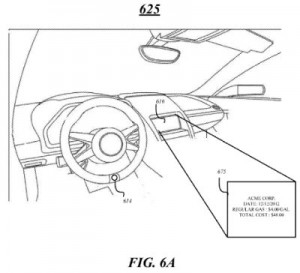 We’ll start our countdown of the top ten patent applications of 2015 with a sector of technological development that will become a recurring theme in this article. Automotive inventions have been cropping up from many other sources than the traditional automaking giants and our tenth-place spot in this list goes to Intel Corporation (NASDAQ:INTC) for its filing of U.S. Patent Application No. 20150220916, titled Techniques for an In-Vehicle Electronic Wallet. It claims an electronic wallet for a vehicle including a vehicle electronic wallet component having a contactless communication interface to receive a payment request when in proximity to a payment processing entity, an electronic wallet authentication component to approve the payment request and an electronic wallet payment component that sends account information corresponding to a payment account over the contactless communication link. This innovation is capable of storing debit and credit card information along with loyalty or stored-value cards, helping a car owner organize various financial and benefits accounts while providing a simplified way to pay for gas and other purchases.
We’ll start our countdown of the top ten patent applications of 2015 with a sector of technological development that will become a recurring theme in this article. Automotive inventions have been cropping up from many other sources than the traditional automaking giants and our tenth-place spot in this list goes to Intel Corporation (NASDAQ:INTC) for its filing of U.S. Patent Application No. 20150220916, titled Techniques for an In-Vehicle Electronic Wallet. It claims an electronic wallet for a vehicle including a vehicle electronic wallet component having a contactless communication interface to receive a payment request when in proximity to a payment processing entity, an electronic wallet authentication component to approve the payment request and an electronic wallet payment component that sends account information corresponding to a payment account over the contactless communication link. This innovation is capable of storing debit and credit card information along with loyalty or stored-value cards, helping a car owner organize various financial and benefits accounts while providing a simplified way to pay for gas and other purchases.
#9: Disney’s Positioning System for Drone Coordination in Aerial Displays
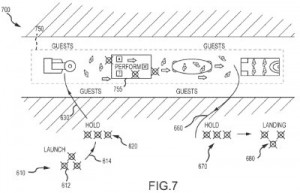 Seemingly every time we have a survey of the top ten innovations, we see some entrant from the Walt Disney Company (NYSE:DIS), which speaks to the imaginative nature of the company’s R&D activities. The ninth-place innovation in our 2015 patent application survey is Disney’s U.S. Patent Application No. 20150269408, titled Visual Localization of Unmanned Aerial Vehicles Based on Marker Detection and Processing. It discloses a localization marker for identification with a single scan direction having a body with an exposed surface and a marker pattern disposed on the surface having a fixed pattern and a date area sandwiched between a pair of linear features. The localization method of this invention is designed to provide real-time positioning data for control of unmanned aerial vehicle (UAV), or drone, fleets which may be choreographed to perform an entertaining aerial display.
Seemingly every time we have a survey of the top ten innovations, we see some entrant from the Walt Disney Company (NYSE:DIS), which speaks to the imaginative nature of the company’s R&D activities. The ninth-place innovation in our 2015 patent application survey is Disney’s U.S. Patent Application No. 20150269408, titled Visual Localization of Unmanned Aerial Vehicles Based on Marker Detection and Processing. It discloses a localization marker for identification with a single scan direction having a body with an exposed surface and a marker pattern disposed on the surface having a fixed pattern and a date area sandwiched between a pair of linear features. The localization method of this invention is designed to provide real-time positioning data for control of unmanned aerial vehicle (UAV), or drone, fleets which may be choreographed to perform an entertaining aerial display.
[Varsity-1]
#8: Boston Dynamics’ Robotics Innovations Supports Orthotic Knee Brace
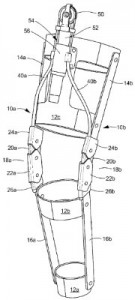 In late August, we profiled some incredibly stunning robotics innovations developed by Alphabet Inc. subsidiary Boston Dynamics, from a cheetah robot racing nearly 30 miles per hour to the 11-pound sand flea which can launch itself 30 feet in the air. The tech company has leveraged its knowledge in joint mechanics, a crucial subject area in robotics, to develop the medical innovation detailed with U.S. Patent Application No. 20150051527, which is titled Brace System. It would protect a brace system having a medial brace and a lateral brace securable via cross members, each brace having an upper and lower portion connected by a hinge assembly, and then a force differential actuator subsystem connected to the medial and lateral braces. This brace system is capable of providing flexion or extension torque to a joint, such as a knee, to lower the load handled by that joint and improve its ability to function.
In late August, we profiled some incredibly stunning robotics innovations developed by Alphabet Inc. subsidiary Boston Dynamics, from a cheetah robot racing nearly 30 miles per hour to the 11-pound sand flea which can launch itself 30 feet in the air. The tech company has leveraged its knowledge in joint mechanics, a crucial subject area in robotics, to develop the medical innovation detailed with U.S. Patent Application No. 20150051527, which is titled Brace System. It would protect a brace system having a medial brace and a lateral brace securable via cross members, each brace having an upper and lower portion connected by a hinge assembly, and then a force differential actuator subsystem connected to the medial and lateral braces. This brace system is capable of providing flexion or extension torque to a joint, such as a knee, to lower the load handled by that joint and improve its ability to function.
#7: General Motor’s Movable Charging Station for Electric Vehicles
 2015 has been, in many ways, the year of the vehicle and seventh-place in our series of patent applications profiled during 2015 goes to GM’s U.S. Patent Application No. 20140354229, titled Electric Vehicle Charging Station. It discloses a vehicle charging station having a track extending along a plurality of vehicle parking spaces and a movable charging apparatus with a power circuit supported by the track and translatable among the plurality of parking spaces. This innovation obviates the need for an electric vehicle owner to manually plug a car into a station for charging, increasing the convenience of charging an electric vehicle.
2015 has been, in many ways, the year of the vehicle and seventh-place in our series of patent applications profiled during 2015 goes to GM’s U.S. Patent Application No. 20140354229, titled Electric Vehicle Charging Station. It discloses a vehicle charging station having a track extending along a plurality of vehicle parking spaces and a movable charging apparatus with a power circuit supported by the track and translatable among the plurality of parking spaces. This innovation obviates the need for an electric vehicle owner to manually plug a car into a station for charging, increasing the convenience of charging an electric vehicle.
#6: University of California’s Solar Collecting Greenhouse Window
Throughout the year, we’ll profile innovations from major American academic institutions, many of which have very strong research activities. One of the most research-intensive university systems is the University of California which takes sixth place in our 2015 patent application survey with U.S. Patent Application No. 20140352762, technically published in 2014 but which we noted in our coverage of the system’s research and development activities in March of this year. It claims a luminescent solar collector designed for both plant growth and electrical power generation which has a luminescent sheet having fluorescent materials absorbing solar photons at certain frequencies and a light energy converter optically coupled to the luminescent sheet. This technology could be incorporated into greenhouse windows, collecting solar energy and transmitting uncollected solar energy in a certain spectrum of color beneficial for vegetative growth and flowering, generating electricity while promoting plant growth.
#5: IBM’s Emotion Analysis for Bank Card Authorization and Security
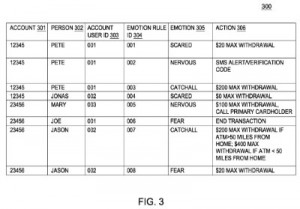 We saw many financial services innovations during a year in which bank account security concerns were necessitating the rollout of EMV chip cards but none felt as novel as the invention that would be protected by IBM’s U.S. Patent Application No. 20150066764, entitled Multi Factor Authentication Rule-Based Intelligent Bank Cards. It discloses a system having a memory containing instructions executable to receive valid authentication information for a card associated with an account, verifying that a captured image of a person presenting the card matches an image of an authorized user of the account, analyzing the captured image to detect a person’s emotion and performing a predefined operation to control access to the account upon determining that the detected emotion satisfies an emotion rule associated with the account. This system would be able to detect if a person was scared or agitated at the point of sale, which could indicate that unauthorized use of the card is being attempted.
We saw many financial services innovations during a year in which bank account security concerns were necessitating the rollout of EMV chip cards but none felt as novel as the invention that would be protected by IBM’s U.S. Patent Application No. 20150066764, entitled Multi Factor Authentication Rule-Based Intelligent Bank Cards. It discloses a system having a memory containing instructions executable to receive valid authentication information for a card associated with an account, verifying that a captured image of a person presenting the card matches an image of an authorized user of the account, analyzing the captured image to detect a person’s emotion and performing a predefined operation to control access to the account upon determining that the detected emotion satisfies an emotion rule associated with the account. This system would be able to detect if a person was scared or agitated at the point of sale, which could indicate that unauthorized use of the card is being attempted.
#4: Samsung’s Low-Power Communications for Wearables, Internet of Things
Our fourth-place patent application for 2015 is an important development for two sectors of technology which have been in our focus in recent years: wearable gadgets and the Internet of Things. This year, the USPTO published Samsung Electronic’s (KRX:005930) U.S. Patent Application No. 20150049657, entitled Apparatus, Method, and System for Low Power Wearable Wireless Devices. It would protect a method for operating an aggregator to transmit information to a user by receiving data from at least one data source, selecting a transmission policy by which the information is to be transmitted to a user and transmitting the information to a user according to the selected policy. This technology enables wireless wearable devices to utilize low-power communications protocols, such as Bluetooth Low Energy, without a loss of functionality for services not supported by those protocols. Again, we have to recognize an honorable mention this year in the field of wearables with the skin stimulation technique for smartphone notifications developed by Microsoft Corporation (NASDAQ:MSFT) and outlined in U.S. Patent Application No. 20150235529, titled Wearable Computer Having a Skin-Stimulating Interface.
#3: Qualcomm’s Wireless Charging Scheme for Electric Vehicles
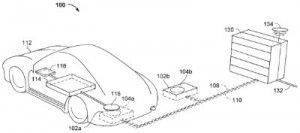 Self-driving technologies were not the only innovation which were disrupting the typical large players in the automotive industry. Some of Silicon Valley was also getting involved in the race to develop commercially successful electric vehicles. The patent landscape for this sector of automotive technology doesn’t reflect much disruption yet, as GM and Ford still maintain leading positions in this sector. However, upstarts like Tesla Motors Inc. (NASDAQ:TSLA) have been stealing some of the EV market for themselves. Elsewhere, our Companies We Follow series has uncovered electric vehicle innovations from such tech firms as IBM (NYSE:IBM), which has developed systems for notifying EV owners of optimal charging periods, and LG Electronics (KRX:066570) with its battery cooling technology for EV battery stacks.
Self-driving technologies were not the only innovation which were disrupting the typical large players in the automotive industry. Some of Silicon Valley was also getting involved in the race to develop commercially successful electric vehicles. The patent landscape for this sector of automotive technology doesn’t reflect much disruption yet, as GM and Ford still maintain leading positions in this sector. However, upstarts like Tesla Motors Inc. (NASDAQ:TSLA) have been stealing some of the EV market for themselves. Elsewhere, our Companies We Follow series has uncovered electric vehicle innovations from such tech firms as IBM (NYSE:IBM), which has developed systems for notifying EV owners of optimal charging periods, and LG Electronics (KRX:066570) with its battery cooling technology for EV battery stacks.
Still, perhaps the most novel EV technology we came across this year, and our third-place patent application, is U.S. Patent Application No. 20150202970, titled Systems and Methods for Electric Vehicle Induction Coil Alignment and filed by Qualcomm, Inc. (NASDAQ:QCOM) It claims a method of receiving wireless power by detecting a transmission signal in a wireless power transmission and determining a phase of a base system induction coil signal based on the detected signal. This summer, we had noted some tech sector activity in wireless induction charging schemes for EVs and discovering this technology confirmed these reports. Honorable mention in wireless charging innovations are extended to Airbus Group SE (EPA:AIR) and its wireless laser-based electric charging system for drones that is discussed in U.S. Patent Application No. 20150311755, titled Wireless Remote Energy Supply for Unmanned Aerial Vehicles.
[Internet-Things]
#2: Google’s Lane Determination for Autonomous Driving Modes
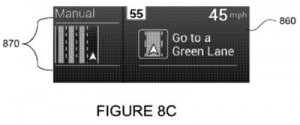 If we’ve said it once, we’ve said it at least 20 times: in our eyes, 2015 was dominated by automotive innovations. As our recent article surveying the state of automotive development in 2015 reflects, self-driving vehicles have been a major focus in the headlines of tech news publications this year. Our own first look at the self-driving car sector came at the 2015 Consumer Electronics Show, where automakers dazzled with a variety of self-navigating vehicles which presage a coming revolution to the entire driving experience. Of great interest to us was not only the self-driving nature of these vehicles but also the major Silicon Valley players, especially from the Alphabet Inc. (NASDAQ:GOOG) subsidiary Google, which had pulled ahead of giant automakers like General Motors Company (NYSE:GM) and Ford Motor Company (NYSE:F) in terms of research and development in autonomous vehicles.
If we’ve said it once, we’ve said it at least 20 times: in our eyes, 2015 was dominated by automotive innovations. As our recent article surveying the state of automotive development in 2015 reflects, self-driving vehicles have been a major focus in the headlines of tech news publications this year. Our own first look at the self-driving car sector came at the 2015 Consumer Electronics Show, where automakers dazzled with a variety of self-navigating vehicles which presage a coming revolution to the entire driving experience. Of great interest to us was not only the self-driving nature of these vehicles but also the major Silicon Valley players, especially from the Alphabet Inc. (NASDAQ:GOOG) subsidiary Google, which had pulled ahead of giant automakers like General Motors Company (NYSE:GM) and Ford Motor Company (NYSE:F) in terms of research and development in autonomous vehicles.
Our second-place patent application for 2015 is Google’s U.S. Patent Application No. 20150192428, entitled Determining and Displaying Auto Drive Lanes in an Autonomous Vehicle. It discloses a computer-implemented method of accessing detailed map information identifying the location of autodrive lanes pre-approved for an autonomous driving mode, identifying at least two autodrive lanes based on the map information and generating display information identifying the autodrive lanes to a driver. This technology is designed to help a driver more easily put the vehicle into an autonomous driving mode by quickly identifying road lanes for which autonomous driving has been approved.
#1: Apple’s Fuel Cell System for Powering Electronic Devices
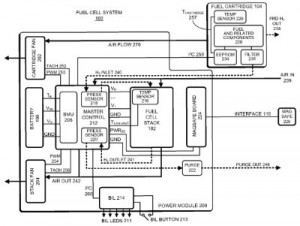 Alternative energy systems such as fuel cells are often a topic of discussion here on IPWatchdog. Hydrogen fuel cell technologies, which generate power through a chemical reaction between hydrogen and oxygen that produces water as a waste product, have been widely discussed for their application in clean energy for automobiles. Despite the lead that electric vehicles (EVs) have in alternatively fueled vehicles, fuel cell vehicles (FCVs) are still under development by major automakers like Toyota Motor Corporation (NYSE:TM) and BMW (ETR:BMW).
Alternative energy systems such as fuel cells are often a topic of discussion here on IPWatchdog. Hydrogen fuel cell technologies, which generate power through a chemical reaction between hydrogen and oxygen that produces water as a waste product, have been widely discussed for their application in clean energy for automobiles. Despite the lead that electric vehicles (EVs) have in alternatively fueled vehicles, fuel cell vehicles (FCVs) are still under development by major automakers like Toyota Motor Corporation (NYSE:TM) and BMW (ETR:BMW).
However, automobiles have a fairly large form factor within which a fuel cell can be enclosed. That’s a big reason why our top patent application for 2015 is U.S. Patent Application No. 20150249280, titled Fuel Cell System to Power a Portable Computing Device and assigned to Apple Inc. (NASDAQ:AAPL) It would protect a fuel cell system for a portable device having a fuel cell stack converting fuel to electrical power, a fuel source, an interface to the portable device having a power link providing power to the device and a controller that receives fuel cell control information to control the system. As the patent application states, it’s incredibly complex to design a hydrogen fuel cell systems that are portable and small enough to be utilized in laptops. Given the fact that issues in hydrogen storage have been a stumbling block preventing further commercialization of the technology, the idea that fuel cells could power something as tiny as a smartphone makes this innovation one of the most forward-looking technologies of 2015.

![[IPWatchdog Logo]](https://ipwatchdog.com/wp-content/themes/IPWatchdog%20-%202023/assets/images/temp/logo-small@2x.png)

![[Advertisement]](https://ipwatchdog.com/wp-content/uploads/2024/04/Patent-Litigation-Masters-2024-sidebar-early-bird-ends-Apr-21-last-chance-700x500-1.jpg)

![[Advertisement]](https://ipwatchdog.com/wp-content/uploads/2021/12/WEBINAR-336-x-280-px.png)
![[Advertisement]](https://ipwatchdog.com/wp-content/uploads/2021/12/2021-Patent-Practice-on-Demand-recorded-Feb-2021-336-x-280.jpg)
![[Advertisement]](https://ipwatchdog.com/wp-content/uploads/2021/12/Ad-4-The-Invent-Patent-System™.png)







Join the Discussion
No comments yet.